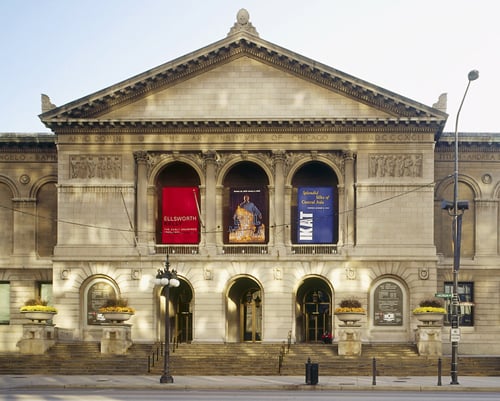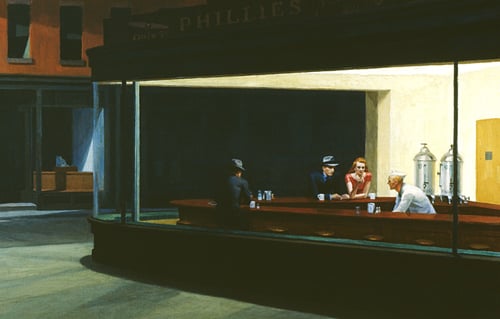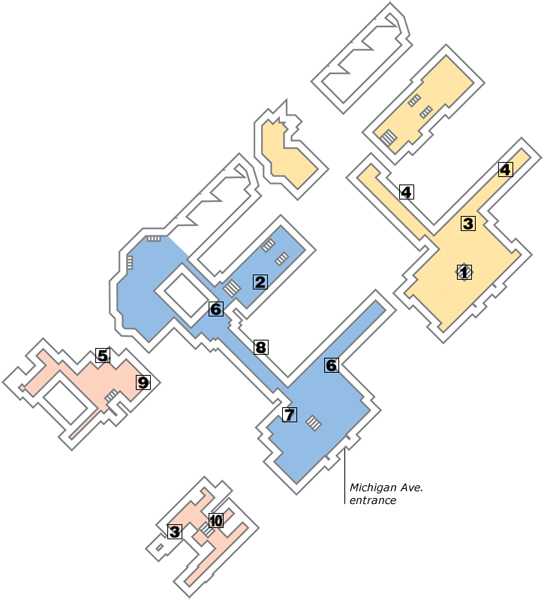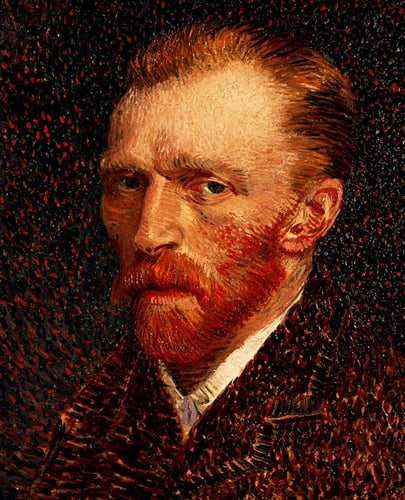Guarded by iconic lions, and up a flight of grand
stone steps (a favorite local meeting place) is the Midwest’s largest,
and one of the USA’s best art museums. Housed in a massive Beaux Arts
edifice (currently being renovated and expanded), the Institute has some
260,000 works from around the globe, and is famous for its
Impressionist and Post-Impressionist works and touring shows.
111 S. Michigan Ave. El Station: Adams (Green, Orange, Purple, & Yellow lines) Monroe (Blue & Red lines) 312 443 3600
www.artic.edu
Open 10:30am–5pm Mon–Fri (to 8pm Thu); 10am–5pm Sat & Sun. DA (at both entrances)
|
|
The Art Institute is
building an addition to the museum as well as undergoing extensive
renovations, all of which will be complete in 2009. The locations of
works and the accessibility of specific galleries are subject to change,
so if there is a particular work you would like to see, please call
ahead first to ensure it is on view.
|


Main museum entrance
|
The Garden Restaurant is a lovely lunch stop. Alternatively, cross over to Cosi ( 116 S. Michigan Ave. ) for great sandwiches.
|
|
|
Join a free, hour-long introductory tour. Meet in gallery 100 (1 or 2pm daily)
|
|
|
Don’t miss the reconstruction of the 1893 Stock Exchange Trading Room.
|
|
|
In summer, catch live jazz in the Garden Restaurant (4:30–7:30pm Thu)
|
|
Top 10 Paintings
A Sunday on La Grande Jatte–1884
Massive and
mesmerizing, this painting took Georges Seurat two years to complete.
The scene is created from dots of color, based on his study of optical
theory, later known as pointillism.
Acrobats at the Cirque Fernando
Children were
often the subjects of Renoir’s sunny paintings: this luminous 1879 work
shows a circus owner’s daughters taking a bow after their act.
At the Moulin Rouge
Unlike many of his
fellow Impressionists who painted serene, often natural scenes,
Toulouse-Lautrec was drawn to the exuberant night- and lowlife of Paris.
This dramatic composition (1892) celebrates the famous Moulin Rouge
cabaret.
Stacks of Wheat series
From 1890–91, Monet
painted 30 views of the haystacks that stood outside his house at
Giverny in France. This museum has six of them, which illustrate the
basic Impressionist doctrine of capturing fleeting moments in nature.
Paris Street; Rainy Day
Considered to be
Gustave Caillebotte’s masterpiece, this evocative 1877 view down a
Parisian boulevard, with life-sized figures in the foreground, perfectly
captures the gray and rainy scene.
Nighthawks
One of the best-known
images in 20th-century American Art, this 1942 painting by Realist
Edward Hopper has a melancholy quality. It cleverly depicts fluorescent
lighting, at the time a recent introduction to US cities.

The Child’s Bath
The only American
to exhibit in Paris with the Impressionists, Mary Cassatt is known for
using then-unconventional techniques such as elevated vantage points.
She often portrayed women and children as in this, her most famous
painting (1892).
The Old Guitarist
A 22-year-old,
struggling Picasso painted this tortured 1903 portrait during his Blue
Period. This reflected his grief over a friend’s suicide and was a
precursor to his own style of Cubism.
The Herring Net
Winslow Homer
honed his realist skills as an illustrator for magazines and later for
the Union during the Civil War. After moving to Maine, he created a
series of images, including this one (1885), depicting man’s complex
relationship with the sea.
American Gothic
Grant Wood
borrowed from the detailed style of Flemish Renaissance art to create
this much-parodied painting (1930). Though perceived by many as
satirical, the painting celebrates rural American values.
Collections

Floorplan
European Paintings Arranged
chronologically, and spanning the Middle Age through 1950, this
prodigious collection includes a significant array of Renaissance and
Baroque art. However, its main draw is a body of nearly 400
Impressionist and Post-Impressionist paintings. Instrumental in its
creation was Bertha Honoré Palmer who acquired over 40 Impressionist
works (largely ignored in France at the time) for the 1893 World’s
Columbian Exposition.

Vincent Van Gogh, Self-portrait (1886–7), European Paintings
American Arts This
impressive holding contains some 5,500 paintings and sculptures dating
from the colonial period to 1950. In addition, paintings and works on
paper are on loan from the Terra collection and there is a range of
decorative arts, including furniture, glass, and ceramics from the 18th
century through to the present. The silver collection is especially
noteworthy. Architecture Given
the city’s strong architectural heritage and focus, it is not
surprising that Chicago’s Art Institute boasts an architecture and
design department, one of only a few in the US. Sketches and drawings
are accessible by appointment, and changing public displays feature
models, drawings, and architectural pieces, such as a stained-glass
window by Frank Lloyd Wright. Modern & Contemporary Art This
important collection represents the significant arts movements in
Europe and the US from 1950 to the present day, including a strong body
of Surrealist works, and notable paintings by Picasso, Matisse, and
Kandinsky, as well as showing how American artists, such as Georgia
O’Keeffe, interpreted European Modernism. A limited number of artworks
will be on view until 2009 while the galleries are being renovated. Photography Spanning
the history of the medium, from its origins in 1839 to the present,
this eminent collection was started by Georgia O’Keeffe in 1949 with the
donation of works by Alfred Stieglitz. Many modern masters, including,
Julien Levy, Edward Weston, Paul Strand, and Eugène Atget, are
represented. Asian Art This
sizeable collection covers 5,000 years and features Chinese ceramics
and jades, Japanese screens, and Southeast Asian sculpture. The museum’s
assemblage of Japanese woodblock prints, such as Courtesan
(c. 1710) by Kaigetsudo Anchi, is one of the finest outside Japan. Look
out, too, for the rare early 14th-century scroll painting, Legends of the Yuzu Nembutsu. African & Amerindian Art A
variety of artifacts, including sculptures, masks, ceramics, furniture,
textiles, bead-, gold-, and metalwork, make up this relatively small,
but interesting collection. Exhibits from both continents are arranged
by region and culture: ceremonial and ritual objects are particularly
intriguing. Arms & Armor The
Harding Collection of Arms and Armor is one of the largest in America.
On permanent display are over 200 items related to the art of war
including weapons, and complete and partial suits of armor for men – as
well as horses. The items displayed originate from Europe, the United
States, and the Middle East, and date from the 15th through the 19th
centuries. Arthur Rubloff Paperweight Collection This
fabulous and unusual assemblage numbers in excess of 1,400
paperweights, making it one of the largest of its kind in the world. It
showcases colorful and exquisite examples from all periods, designs, and
techniques. The paperweights mostly originate from 19th-century France,
though some were made in America and the United Kingdom. Displays also
reveal the secrets of how paperweights are made. Thorne Miniature Rooms Narcissa
Ward Thorne, a Chicago art patron, combined her love of miniatures with
her interest in interiors and decorative arts to create the 68 rooms in
this unique Lilliputian installation. Some of the 1 inch:1 foot scale
rooms are replicas of specific historic interiors, while others are
period recreations, combining features copied from a variety of sites or
based on illustrations and other records of period furniture.
|